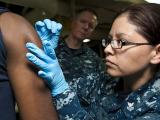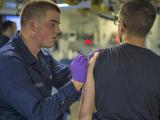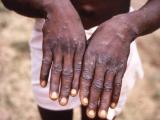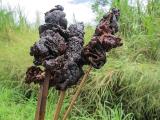Mar 10, 2004 (CIDRAP News) Two studies announced by federal health officials today suggest that modified vaccinia Ankara (MVA), a weakened form of the conventional smallpox vaccine, could provide a safer way to provide smallpox immunity to people at risk for complications from the standard vaccine.
In one study, published in Nature, MVA was almost as effective as the standard vaccine in protecting monkeys from monkeypox, a close relative of smallpox. The other study showed that MVA protected both healthy and immune-deficient mice against a normally deadly dose of vaccinia, the virus used to make smallpox vaccine. The second study is to be published in the online early edition of the Proceedings of the National Academy of Sciences.
Both studies were led by researchers with the National Institute of Allergy and Infectious Diseases (NIAID). NIAID Director Anthony S. Fauci, MD, commenting on the monkeypox study in a news release, said, "These findings are important to the search for a replacement vaccine for people with health conditions that would prevent them from using the current smallpox vaccine. In addition, because an initial MVA injection may help lessen the side effects experienced from Dryvax [the standard vaccine], MVA may serve as an important pre-vaccine for large-scale vaccination efforts in the event of a bioterror threat involving smallpox."
People with an increased risk of complications from Dryvax include those who have weakened immune systems because of HIV, cancer chemotherapy, or immunosuppressive treatments associated with organ transplants. Also at risk are pregnant women, infants less than a year old, and people with a history of eczema.
Developed in Germany in the 1960s, MVA is a greatly weakened form of the vaccinia virus that cannot multiply and infect mammalian cells, according to the NIAID. The vaccine was tested for safety when it was first developed but has not been tested for effectiveness against smallpox, the agency noted.
To test MVA's effectiveness against monkeypox, researchers led by Bernard Moss divided 24 cynomolgous monkeys into four groups of six, the NIAID reported. The first group received two MVA injections 2 months apart, while the second group received MVA vaccine followed by Dryvax 2 months later. The third group received no initial injection but received a Dryvax injection after 2 months. The fourth group, serving as a control, received no vaccines.
All the monkeys received intravenous doses of monkeypox virus 2 months after the second vaccination. The control monkeys all became seriously ill with hundreds of lesions, and one died, according to the Nature report. The monkeys immunized with Dryvax or with MVA and Dryvax had no illness or detectable lesions. Those that received MVA alone had a small number (1 to 36) of lesions but otherwise remained healthy, and their lesions healed faster than those in the control animals.
The researchers also examined the monkeys' vaccination lesions and their immune system responses to the vaccines. "Monkeys that received Dryvax alone developed the characteristic fluid-filled skin lesions, while those that received MVA prior to Dryvax had much smaller lesions," the NIAID said. The MVA-only group had no vaccination lesions.
The investigators also found that the immune responses triggered by the MVA vaccine and by Dryvax were similar in regard to both antibodies and killer T-cells, the NIAID said.
In the Nature report, the authors call their findings "important steps in the evaluation of MVA as a replacement vaccine" for those at risk for severe side effects from the standard vaccine. They add, "One approach would be to vaccinate with MVA before any immediate smallpox threat, with the expectation that a standard vaccine or a second MVA (depending on individual risk factors) would be given as a boost in the event of documented smallpox."
In the mouse experiment, also led by Moss, both normal and immune-deficient mice were vaccinated with MVA and then exposed to a normally lethal dose of vaccinia virus, according to the NIAID. Both groups survived. The immune-deficient mice lacked antibody-producing cells or proteins that help alert killer T-cells to an infection, the NIAID said, without providing further details.
See also:
Mar 10 NIAID news release
http://www.niaid.nih.gov/news/newsreleases/2004/Pages/mvavac.aspx



















